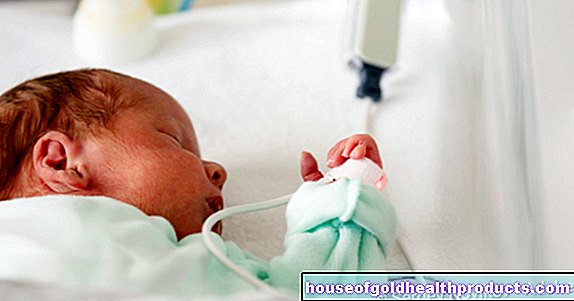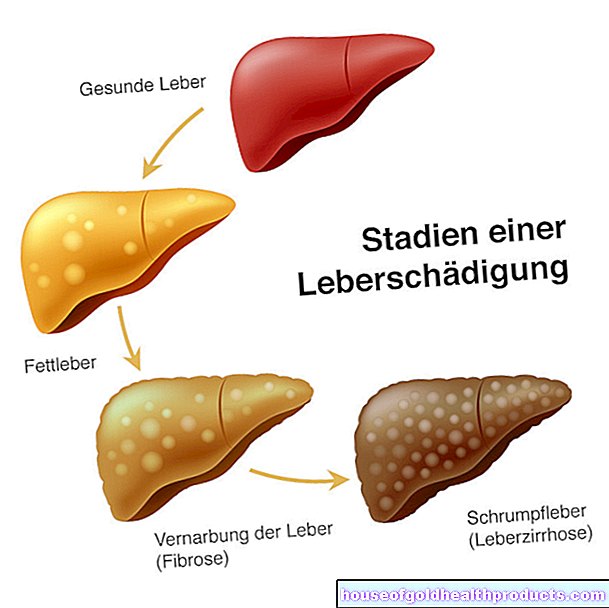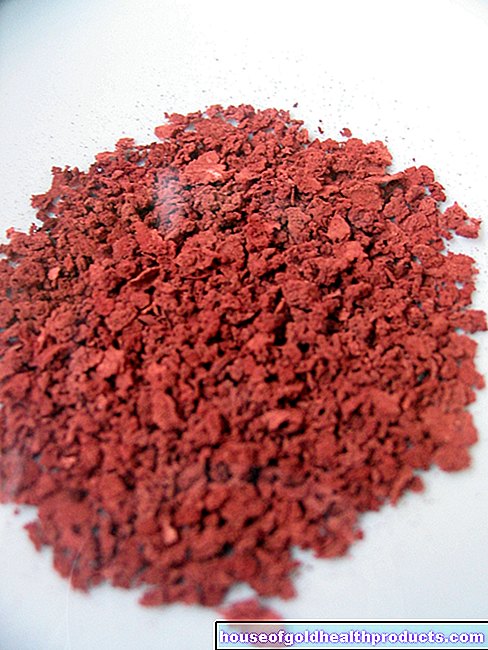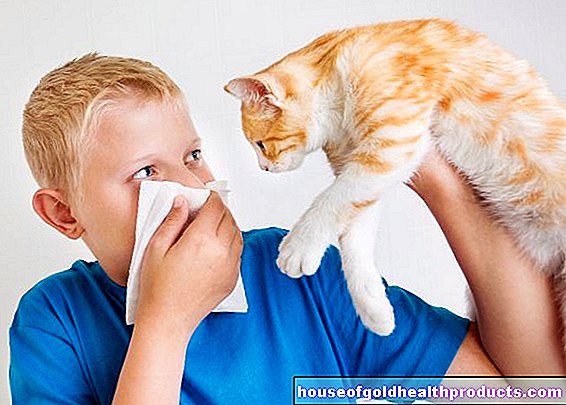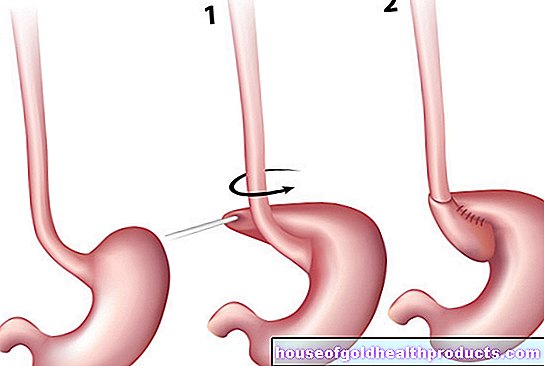Animal hair allergy
Astrid Leitner studied veterinary medicine in Vienna. After ten years in veterinary practice and the birth of her daughter, she switched - more by chance - to medical journalism. It quickly became clear that her interest in medical topics and her love of writing were the perfect combination for her. Astrid Leitner lives with daughter, dog and cat in Vienna and Upper Austria.
More about the experts All content is checked by medical journalists.Watery eyes, a runny or blocked nose or rashes after contact with an animal? Perhaps the reason is an allergy to pet hair. Read here which pets are most likely to cause allergies, when you should see a doctor and what helps against the symptoms.
ICD codes for this disease: ICD codes are internationally recognized codes for medical diagnoses. They can be found, for example, in doctor's letters or on certificates of incapacity for work. T78

Brief overview
- Symptoms: sneezing, runny or stuffy nose, red eyes, itchy rash
- Treatment: anti-inflammatory and antiallergic nasal sprays, tablets and ointments, avoidance of the offending animal, desensitization
- Course: If left untreated, allergic asthma can develop from an animal hair allergy; the allergy rarely heals spontaneously
- Description: Allergic reaction after contact with animals
- Causes and risk factors: The cause is not the hair itself, but proteins from the animal's saliva, sweat, sebum or urine
- Diagnostics: prick test, blood test, provocation test
- Prevention: Avoid contact with animals, animal-free environment
How do you recognize a pet hair allergy?
An animal hair allergy typically occurs immediately after contact with an animal. Symptoms usually develop within a few minutes. Mainly the respiratory tract and the skin are affected. The symptoms of a pet hair allergy are similar to those of a pollen allergy (hay fever). In contrast to the pollen allergy, the allergy to animal hair occurs all year round.
The following symptoms are signs of a pet hair allergy:
- Sneezing, runny or stuffy nose with no other signs of a cold
- Red, itchy, or watery eyes (conjunctivitis)
- cough
- Rash, reddening of the skin
- Swelling of the eyelids (eyelid edema)
- Itchy wheals on the skin (hives)
- Pimples on the skin (from skin irritation)
- Scratches caused by animals swell a lot
- Headache and / or sore throat
- Difficulty concentrating
- Difficulty sleeping from sleeping with your mouth open
In severe cases, a pet hair allergy can lead to the following symptoms:
- Shortness of breath
- Asthma attack
- Anaphylactic shock
In severe cases, an allergic reaction to animal hair causes life-threatening allergic shock (anaphylactic shock) with symptoms such as nausea, vomiting, or a drop in blood pressure. In the worst case, it leads to respiratory and circulatory arrest. Anyone who develops symptoms such as shortness of breath, tingling in the palms of the hands and soles of the feet, dizziness or sweating should therefore call an emergency doctor immediately!
Effects and possible secondary diseases of an animal allergy
It is essential that you take signs of a pet hair allergy seriously to avoid any health consequences:
- If the animal hair allergy is left untreated, the risk of allergic asthma increases.
- Symptoms of neurodermatitis (atopic eczema) can worsen.
- Animal scales and bird feathers are ideal breeding grounds for house dust mites, which increases the risk of a house dust mite allergy.
- An aquarium in the household increases the humidity: mites and molds thrive better and the risk of corresponding allergies increases.
- The animal's environment also plays a role: forage crabs in fish feed or mold in rodent hay are also considered to be potential triggers for allergies.
What can you do about a pet hair allergy?
If there are signs of a pet hair allergy, it is important to act quickly. Only timely treatment will prevent the symptoms from worsening permanently and the allergy from developing into allergic asthma.
What can you do yourself if you have a pet hair allergy?
In the case of mild symptoms such as mild conjunctivitis (without suspicion of asthma), the following tips will help alleviate the symptoms:
- If possible, keep the animal out of the living area. If that is not possible, make sure that at least he is not in the bedroom.
- Don't let the animal lick you!
- Wash your hands immediately after contact with the animal.
- Groom the fur outside of the living area.
- Wash the animal regularly or wipe it with a damp cloth. How to reduce the spread of allergens.
- Avoid "dust catchers" such as carpets, upholstered furniture, plush toys, pillows and curtains.
- Remove allergens from clothing with a clothes roller.
- Wash clothes, bed linen and other textiles regularly at at least 60 degrees.
- Vacuum and mop furniture and floors daily.
- Use a vacuum cleaner with hypoallergenic HEPA filters; Vacuum cleaners remove more allergens than dry vacuum cleaners.
- Ventilate the living spaces regularly to reduce the concentration of allergens in the air.
- Avoid close contact with the allergy-causing animal.
- Avoid indirect contact with animals such as visits to households with animals.
Medication
Medicines alleviate the acute symptoms of an animal hair allergy. However, they only fight the symptoms, but do not cure the allergy. They are not suitable for permanent use. Despite medication, it can happen that the symptoms worsen as the allergy persists.
Nasal sprays and eye drops
Antiallergic nasal sprays and eye drops contain antihistamines or mast cell stabilizers. They prevent the body's own substance, histamine, from triggering an allergic reaction.
If the symptoms are more severe, the doctor will also prescribe nasal drops or eye drops containing the active ingredient cortisone. They have a decongestant and anti-inflammatory effect.
Allergy tablets
Antihistamines are also available in tablet form. They work longer and throughout the body.
Ointments containing cortisone
The doctor treats allergy-related skin rashes with ointments containing cortisone.
Separation from the animal
The easiest and most efficient way to reduce the symptoms of an animal hair allergy and avoid the development of asthma is the so-called “allergy avoidance”. It consists in avoiding contact with the animal. For some of those affected, this means separation from their pets.
After the animal has moved out, it can take some time for the symptoms to subside: allergens are still present in textiles for months after the apartment has been thoroughly cleaned.
Desensitization
A so-called desensitization, also known colloquially as desensitization or allergy vaccination, is only carried out by the doctor in exceptional cases in the case of animal hair allergies. The reason for this is that it is usually possible to avoid allergies. If the symptoms are very severe or if contact with animals is unavoidable, the doctor suggests desensitization. This is the case, for example, with visually impaired people with guide dogs or veterinarians.
In this treatment, also known as “specific immunotherapy” (SIT), the patient receives the allergen in increasing doses for at least three years, either as an injection or as a tablet. This “trains” the immune system: It gets used to the substance that is harmless to the body and no longer classifies it as dangerous. Allergic reactions diminish over time or do not occur at all. However, desensitization does not guarantee that the patient will then be completely allergy-free and thus completely cured.
While the desensitization in pollen and house dust mite allergies has been well tested and promising, little research has been done on it in the case of animal hair allergies. According to the current state of knowledge, it works best for cat hair allergies. However, since it takes at least three years to achieve good results, this form of therapy is usually not an option for allergy sufferers who already have an animal. It is also known that the treatment of animal hair allergies is more likely to cause side effects such as asthma attacks.
Home remedies
Several home remedies can help temporarily relieve symptoms of a pet hair allergy:
Nasal douche
Mix ¼ teaspoon salt with ¼ teaspoon baking soda and dissolve both in a cup of warm water. Now fill the solution into a nasal douche (available from the pharmacy). Hold your head over a sink and tilt it to one side. Pour the solution into the higher nostril and let it drain down the lower nostril and throat. Spit out the rest and blow your nose carefully.
Inhalation with thyme
Thyme contains the active ingredient thymol. It has an anti-inflammatory effect and so relieves swelling in the respiratory tract. Pour two cups of boiling water over ¼ cup of dried thyme and let the mixture sit, covered, for two hours. Then remove the lid and inhale the vapors deeply through your nose several times.
homeopathy
Euphrasia and Acidum formicicum are described as homeopathic remedies for allergic symptoms.
The concept of homeopathy and its specific effectiveness are controversial in science and not clearly proven by studies.
Can you suddenly get a pet hair allergy? Can a pet hair allergy go away?
An allergy to a pet can develop suddenly. Even people who have lived in a household with a pet for years without any problems sometimes develop an allergy to pet hair from one day to the next. The reason for this is unclear.
People who are already sensitive or allergic to other substances such as pollen or house dust mites generally have an increased risk of an animal hair allergy. It is not known exactly what causes the allergy to break out. Experts assume that a certain genetic predisposition plays a role.
Pet hair allergies have a tendency to get worse over time. If left untreated, it increases the risk for those affected to develop allergic asthma. In this case, the doctor speaks of a “change of floor”: the inflammatory processes spread from the upper to the lower airways (lungs and bronchi).
The severity of the symptoms varies and can change over the course of life. Children are often more sensitive to allergens because their immune systems are not yet fully developed. However, allergies in infants and toddlers may go away on their own after a few years.
It happens that allergies improve with age. Experts suspect here that the cause is a weakening immune system, which reacts less and less sensitively. How an animal hair allergy will develop in each individual - whether it will improve or worsen - cannot be predicted.
What is a pet hair allergy?
An animal hair allergy is an allergic reaction after contact with an animal. It is the third most common allergy after pollen and house dust mite allergies. In principle, any animal with fur or feathers that lives closely with people can trigger an allergy. The most common cause of allergy to animal hair is cats, followed by guinea pigs, hamsters, rabbits, rats, mice, horses, cattle and dogs. However, allergies are also triggered by feathers, bird droppings and fish food.
Often those affected are allergic not only to a single animal species, but to two or more species at the same time. For example, around 30% of all cat allergy sufferers are allergic to another animal species, and 20% even to several animal species.
Cats: In most cases of animal hair allergy, people are allergic to cats. The allergens are found in saliva, sebum and anal glands, skin and tear fluid.When cleaning, the cat spreads the allergens in the fur. Since they are very small and light, they adhere well to dust particles and thus get into the room air, where they can float for a long time. Allergy sufferers therefore often react to cat allergens even though the cat is not in the same room at the moment.
Birds: The allergens are mainly found in feathers and bird droppings. Mites in the plumage can also cause allergic symptoms. In these cases, those affected are often and additionally allergic to house dust mites.
Guinea pigs: In people who are allergic to guinea pigs, the immune system produces antibodies against proteins in the urine.
Rabbits, hamsters: In rabbits and hamsters, the allergens are mainly found in the urine, in skin flakes and in the fur.
Mice and rats: Particularly in mice and rats, severe allergic reactions are possible in sensitive people. The allergens are in the urine.
Dog: Dogs are generally less allergenic than cats. The allergens are found in the skin, hair, saliva and urine.
Materials of animal origin (for example horsehair mattresses or down comforters) are also possible triggers for allergies!
Which animals can you keep as an allergy sufferer?
Animal hair allergies are mainly caused by animals that wear fur or feathers. All of them produce proteins that can potentially lead to allergic reactions. However, symptoms do not always appear.
Reptiles such as lizards or snakes or fish do not cause allergies themselves. Allergic reactions are still possible when dealing with these animals: Food animals (grasshoppers) and fish food (crabs) often contain allergens. The allergy-causing particles of undigested insects can get into the human respiratory tract via the room air via the excretions of the animals and promote allergies.
Anyone who is allergic to a certain animal is not automatically allergic to all individuals of that species. The production of allergens differs from breed to breed, but above all from animal to animal. For example, non-neutered male cats should emit more allergens than neutered male and female cats, and short-haired dogs more than long-haired ones. However, there are no animal species that are basically “allergy-friendly” or “allergy-free”.
Causes and Risk Factors
In the case of an allergy, the immune system reacts to actually harmless substances (allergens). It falsely recognizes the allergen as threatening and counteracts it with an exaggerated defense reaction. The immune system forms defense substances (antibodies) and releases large amounts of histamine. This causes allergic symptoms such as runny nose, itching and rashes.
In the case of an animal hair allergy, the body does not react - as the name suggests - to the animal hair itself, but to protein-containing components in the animal's saliva, sweat, sebum or urine. The allergens are distributed in the fur (or in the feathers) and thus in the surrounding area through the care of the fur and plumage. If the hair is whirled up, it binds to dust particles and may float in the air for a long time before it ends up in clothes or textiles or is inhaled (inhalation allergy).
Animal hair allergies also occur when there is no animal around. The allergens, for example, get through the clothing of pet owners in environments that are normally "animal-free", such as schools or homes without animals!
Sensitization or allergy?
Repeated contact with an allergen is a prerequisite for the development of an allergy. The first time they come into contact with an animal, those affected do not develop any symptoms, but the immune system already reacts. So-called "sensitization" occurs: The body becomes sensitive (i.e. it becomes sensitized) to a certain allergen and begins to produce defense substances (antibodies) against it. Sometimes only a few days pass between the first contact and the first appearance of symptoms, but sometimes several years.
If there is renewed contact, the immune system remembers the allergen: It activates all available defense mechanisms. This leads to an allergic reaction.
Risk factors
As with all allergies, genes also play an important role in animal hair allergies. Certain genetic predispositions increase the likelihood of developing an allergy. If one parent is affected, a child has an allergy risk of around 20 percent. If a sibling is affected, the risk is between 25 and 30 percent. If both parents have an allergy, there is a 50 percent chance that the child will develop an allergy. People with no previous family history have a significantly lower allergy risk at 5 to 15 percent.
The allergy itself cannot be inherited, but the predisposition to develop an allergy is.
diagnosis
See a doctor at the first signs of a pet hair allergy! Only early treatment can stop the disease from getting worse and lower the risk of allergic asthma.
The first point of contact if an animal hair allergy is suspected is the family doctor, and later, if necessary, the dermatologist / allergist. When making the diagnosis, the doctor first asks about the medical history and asks the following questions, among other things:
- What are the current complaints?
- When did the symptoms first appear?
- Do you have your own pet or are you in contact with an animal?
- Do the complaints arise at a certain time of the year or in a certain place?
- Have you observed certain triggers such as animal contact for the complaints?
- What is the living situation like (e.g. animals, aquarium, damp apartment)?
- Are there allergies or asthma in the family?
- Have allergy tests or treatments already been carried out?
In order to find out whether it is actually an allergy to animal hair, the doctor will carry out various tests. These include:
Skin test (prick test)
In the prick test, the doctor tests the skin's reaction to various allergens. This enables him to confirm or exclude a corresponding sensitization.
Sensitization means that the body is sensitive to a certain allergen and the immune system has already made antibodies against it.
To do this, different allergen-containing solutions are applied to the inside of the forearm at a slight distance from each other. Then the skin is slightly scratched at these points with a lancet so that the allergens can get into the skin. If the skin reacts allergically to a certain substance, a so-called wheal forms in the corresponding area on the skin after about 20 minutes: the area swells, is reddened and itchy.
In general: the larger the wheal, the clearer the indication of a corresponding sensitization. But: A positive prick test is not yet proof of an existing allergy, but only of a corresponding sensitization. In the event of renewed contact, allergic symptoms may - but need not necessarily - occur.
If there are no complaints yet, but the allergy test is positive, one speaks of sensitization. This is the case for around 10 percent of the population.
Blood test
Sensitization to animal hair can also be determined by taking a blood sample. If an animal hair allergy is suspected, the doctor checks whether certain antibodies (IgE) are present in increased concentrations in the blood. If the value is significantly increased, this indicates a corresponding allergy. However, it can also indicate parasites or certain blood diseases such as mastocytosis, so it is also not clear evidence. Smokers also often have elevated IgE levels without being allergic to them.
Provocation test
Usually, a skin prick test and blood test are enough to unequivocally diagnose an animal hair allergy. In rare cases it is necessary to conduct a provocation test. The doctor uses this to check whether the symptoms are actually caused by the suspected allergen. In this test, the doctor "provokes" the nose by dripping or spraying the suspected allergen directly onto the mucous membrane. If the typical symptoms such as sneezing, runny or blocked nose occur, this is considered evidence of an allergy.
Allergy tests are possible at any age. Even infants are tested if they suspect an animal hair allergy.
prevention
Anyone suffering from an animal hair allergy should avoid contact with the animals as much as possible. If you don't (yet) have an allergy, but have a family history, you don't necessarily have to do without a pet. Studies have shown that keeping a dog, for example, can even have a positive effect. However, people should not keep cats if they come from a "risk family". This may help prevent an animal hair allergy.
Tags: sleep hospital alcohol
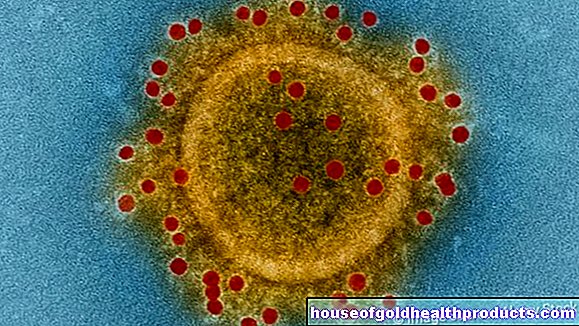
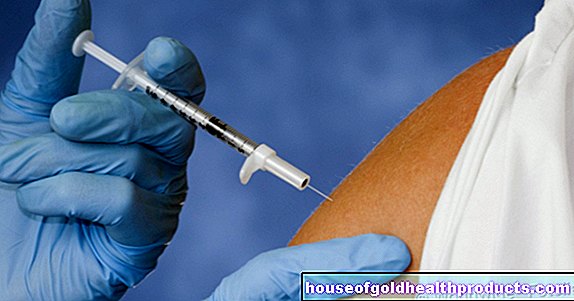



.jpg)
